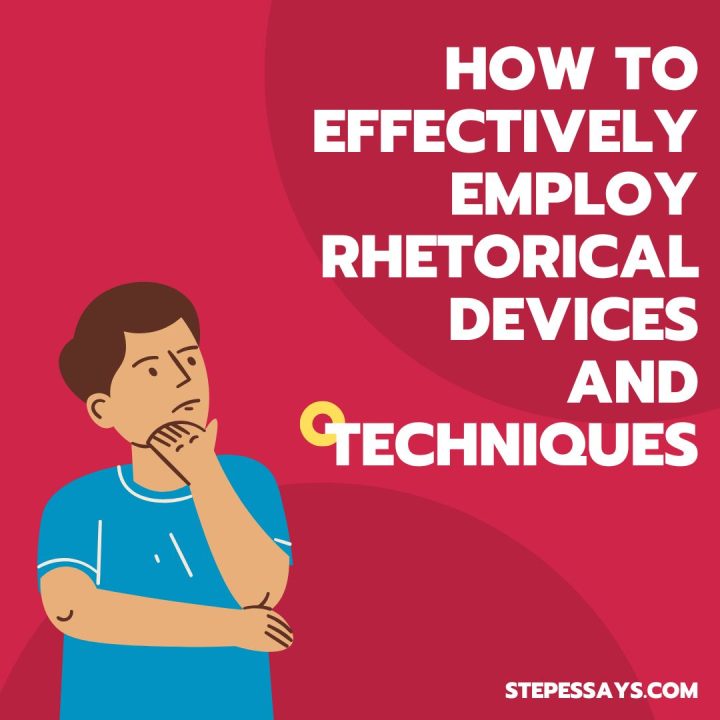Introduction:
Rhetorical devices are indispensable tools for effective communication. Whether in persuasive writing, public speaking, or everyday conversation, mastering rhetorical techniques can elevate your message, capture attention, and persuade audiences. From the subtle use of irony to the powerful impact of repetition, these devices shape language in ways that engage, inform, and inspire. In this comprehensive guide, we will delve into the art of employing rhetorical devices effectively, exploring their definitions, functions, and applications across various contexts.

Rhetorical Devices and Techniques
I. Understanding Rhetorical Devices:
- Definition and Purpose:
- Rhetorical devices encompass a range of linguistic techniques employed to enhance communication.
- The primary purpose is to evoke emotional responses, persuade, or emphasize key points.
- Devices may be used consciously or unconsciously, but understanding them empowers communicators to wield language with precision.
- Types of Rhetorical Devices:
- Figures of speech: Simile, metaphor, personification, hyperbole.
- Sound devices: Alliteration, assonance, consonance, onomatopoeia.
- Structural devices: Parallelism, chiasmus, anaphora, epistrophe.
- Logical devices: Rhetorical questions, irony, paradox, antithesis.
II. Employing Rhetorical Devices Effectively:
- Tailoring Devices to Audience and Purpose:
- Recognize the demographics, preferences, and expectations of your audience.
- Choose devices that resonate with your audience and align with your communication goals.
- Adapt your use of devices based on the context, whether formal or informal, serious or light-hearted.
- Enhancing Persuasion:
- Employ devices such as ethos, pathos, and logos to establish credibility, evoke emotions, and appeal to reason.
- Use anecdotes, testimonials, and vivid imagery to make abstract concepts relatable and persuasive.
- Craft compelling narratives that draw audiences in and lead them to your desired conclusion.
- Creating Memorable Speeches:
- Utilize rhetorical devices to create rhythm, cadence, and flow in your speeches.
- Employ repetition for emphasis, employing anaphora or epistrophe to reinforce key ideas.
- Incorporate strategic pauses, pacing, and tone variations to maintain engagement and highlight important points.
- Crafting Engaging Writing:
- Employ literary devices to add depth, imagery, and resonance to your prose.
- Experiment with wordplay, symbolism, and irony to captivate readers and provoke thought.
- Balance simplicity and complexity, tailoring your use of devices to the genre, audience, and purpose of your writing.
III. Examples and Applications:
- Political Speeches:
- Analyze iconic speeches such as Martin Luther King Jr.’s “I Have a Dream” for their use of rhetorical devices to inspire social change.
- Examine the strategies employed by politicians to sway public opinion and rally support for their agendas.
- Advertising and Marketing:
- Explore how advertisers use rhetorical devices to create memorable slogans, jingles, and brand identities.
- Deconstruct marketing campaigns to uncover the persuasive techniques employed to influence consumer behavior.
- Literature and Poetry:
- Examine literary works to identify the use of metaphor, symbolism, and other rhetorical devices to convey themes and emotions.
- Study renowned poets like Emily Dickinson and Langston Hughes to understand how they employ sound devices and imagery to create evocative poetry.
IV. Challenges and Considerations:
- Avoiding Overuse and Cliché:
- Exercise restraint to prevent the overuse of rhetorical devices, which can diminish their impact and come across as contrived.
- Strive for authenticity and originality, avoiding clichés and tired expressions that fail to resonate with modern audiences.
- Cultural Sensitivity:
- Recognize that rhetorical devices may carry different connotations or effectiveness across cultures.
- Consider the cultural background and sensitivities of your audience when employing devices to ensure clarity and respect.
- Ethical Considerations:
- Avoiding Manipulation:
- Using rhetorical devices responsibly and ethically to inform, persuade, and inspire rather than manipulate or deceive.
- Respecting the audience’s intelligence and autonomy by presenting honest, accurate information.
- Maintaining Integrity:
- Upholding credibility and trustworthiness by aligning rhetoric with truth, sincerity, and ethical principles.
- Avoiding fallacious arguments, deceptive tactics, and misleading rhetoric.
- Avoiding Manipulation:
V. Advanced Strategies:
- Parallelism:
- Structuring sentences or phrases with similar grammatical structures for emphasis and rhythm.
- Enhancing readability and memorability through parallel construction.
- Repetition:
- Repeating words, phrases, or ideas for emphasis, persuasion, or aesthetic effect.
- Reinforcing key messages and creating a sense of urgency or importance.
- Anaphora and Epistrophe:
- Anaphora: Repetition of words or phrases at the beginning of successive clauses or sentences.
- Epistrophe: Repetition of words or phrases at the end of successive clauses or sentences.
- Building momentum and reinforcing ideas through strategic repetition.
VI Mastering Rhetorical Techniques:
- Ethos, Pathos, Logos:
- Understanding Aristotle’s three pillars of persuasion.
- Ethos: Establishing credibility and trust.
- Pathos: Appealing to emotions to evoke empathy and connection.
- Logos: Employing logic and reason to convince the audience.
- The Power of Storytelling:
- Narrative techniques: Character development, conflict, resolution.
- Using personal anecdotes, case studies, and testimonials to illustrate points and engage the audience emotionally.
- Tone and Voice:
- Adapting tone to suit the audience and context.
- Establishing a consistent voice for authenticity and credibility.
- Structure and Organization:
- Introduction, body, conclusion: Crafting a coherent and persuasive argument.
- Utilizing rhetorical patterns such as chronological, spatial, cause-effect, or problem-solution.
Conclusion:
Mastering rhetorical devices is an essential skill for effective communication in any field. By understanding the various types of devices, tailoring them to your audience and purpose, and practicing their application across different contexts, you can elevate your speech and writing to new heights. Whether seeking to persuade, entertain, or inform, the strategic use of rhetorical devices enables you to craft messages that resonate, inspire, and endure in the minds of your audience. So, embrace the art of rhetoric, and let your words wield the power to captivate, convince, and change the world.
